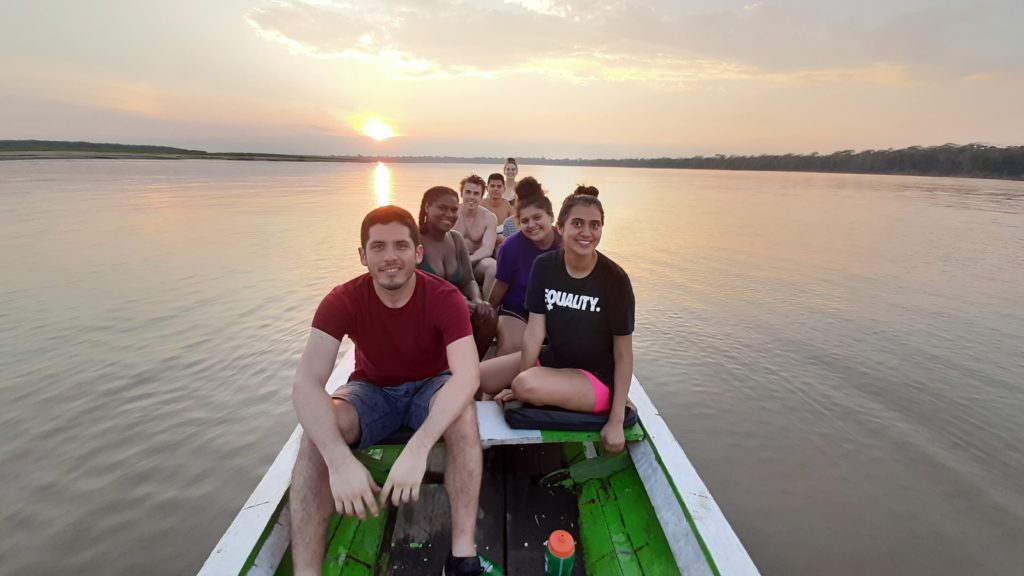A Comparison at a Glance
https://www.holycross.edu/ vs. https://www.pucp.edu.pe/en/
Student Population
HC: 3,102 full time undergraduate students
PUCP: 23,342 undergraduate students
Dining
HC: Kimball Dining hall is the main all-you-can-eat dining hall on campus. Kimball is open from 7am until 8pm, every day of the week. There are also a few other locations on campus where you can purchase sandwiches, salads, snacks, and coffee. The majority of students elect a meal plan which gives them unlimited swipe access to Kimball, as well as a couple hundred dining dollars to use at the various other locations on campus.
PUCP: There are three major “comedors” on campus. A “comedor” is a dining hall in which you can order full meals. Most students order the Menu Universitario, which usually includes a salad, a main dish, a dessert, and a drink. They also have a vegetarian option, as well as a “plate of the day” and a lighter fare option which you can get at these dining halls for very reasonable prices. In addition to these dining halls, there are many small cafés on campus which serve small sandwiches, breads, desserts, drinks, etc.. One of my favorite things on campus is the fruit stand. This has tons of fruits as well as other healthy snacks and smoothies. It is great when you simply need an apple to get you through your next class.
Housing
HC: Primarily On-Campus residential halls. Additionally, there are a few close off-campus options that some students choose to pursue junior and senior year.
PUCP: NO on-campus housing. Some students live multiple hours from school and commute each day. Many students live in the various surrounding municipalities of Lima.
Class sizes
HC: Besides a few intro classes, the majority of classes which I have taken have had about 20-30 students.
PUCP: One of my classes is a required class for Peruvians, and therefor has about 100 students in it. My other three classes are taught in smaller classrooms and have about 25-40 students.
Homework
HC: As I have taken mainly reading-based classes, I normally had 30-50 pages of reading due for each day of class. This usually added up to about 60-100 pages of reading per class per week.
PUCP: My classes at PUCP are either one or two times per week. On average, each class has about 60 pages of reading per week. For one of my classes, there is a required 1-2 paragraph reflection due each week on the required readings.
Campus
HC: On a MOUNTAIN. Greenspaces between buildings. Not particularly large (takes 10 minutes to get from one side of campus to the other). All the buildings are fully indoors. Only three main academic buildings/complexes. Large athletic complex and multiple athletic fields for competition and practice.


PUCP: FLAT. Lots of green spaces in which students eat lunch, socialize, and take part in events. Academic buildings are spread out across campus, making the campus feel larger than at Holy Cross. Stairwells and hallways of buildings are generally outside. Each subject, (ex. social sciences, law, engineering, etc.), has its own building/complex. Much smaller athletic complex. Courts for basketball, as well as soccer fields, and a track(supposedly…. I honestly have not personally witnessed this).

Religious Presence
HC: Jesuit Catholic. Jesuit ideals, as well as many Jesuits themselves, are particularly present on campus. Many students attend mass weekly and participate in activities through the chaplain’s office.
PUCP: Catholic. While there are sometimes small catholic related things that catch my eye, there is no obvious catholic presence on campus that I have noticed. All Peruvian students are required to take a theology course.
Sports
HC: Division one, highly competitive teams, as well as intramural and club sports.
PUCP: Multiple sports teams which compete against other schools, yet are not the same caliber as D1 at Holy Cross. There are also many times when anyone can participate in sports for fun and fitness. There are workshops and times when you can learn different sports as well. Unlike Holy Cross, PUCP also has Chess, Judo, and Table Tennis!! http://deportes.pucp.edu.pe/deportes/
Language of courses
HC: English
PUCP: Spanish (yet a few readings for classes may be in English)
Libraries
HC: Three dominant libraries: Dinand Main Library, Science Library, Music Library. At each of the libraries there is a combination of tables(normally for four people), individual study cubicles, and computers. Dinand Library has the most extensive hours out of the libraries, and the largest seating capacity.

PUCP: Central Library, Academic Innovation Complex Library, Social Sciences Library, Theology Library, Center for Oriental Studies Library. The first three libraries mentioned, are all large buildings with various areas to sit and read, meet for group projects, etc. There are also other buildings with large study spaces.


Security
HC: public safety; a few monitored gates
PUCP: guards at every entrance and must show student ID to enter








